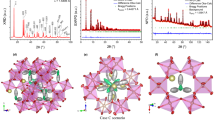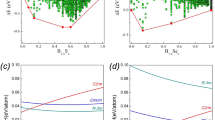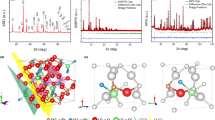Abstract
THE existence of molybdenum sesquisulphide, Mo2S3, as a distinct phase has been in doubt for a considerable time. It was only in 1955 that McCabe1 convincingly demonstrated the existence of the phase and obtained its X-ray powder pattern. An attempt to index the powder pattern has been made by Stubbles and Richardson2; they tentatively propose a tetragonal unit cell with c = 10.9 Å.; c/a = 1.27.
This is a preview of subscription content, access via your institution
Access options
Subscribe to this journal
Receive 51 print issues and online access
$199.00 per year
only $3.90 per issue
Buy this article
- Purchase on Springer Link
- Instant access to full article PDF
Prices may be subject to local taxes which are calculated during checkout
Similar content being viewed by others
References
McCabe, C. L., J. Metals, 7, 61 (1955).
Stubbles, J. R., and Richardson, F. D., Trans. Farad. Soc., 56, 1460 (1960).
Dickinson, R. G., and Pauling, L., J. Amer. Chem. Soc., 45, 1465 (1923). Jellinek, F., Brauer, G., and Müller, H., Nature, 185, 376 (1960).
Author information
Authors and Affiliations
Rights and permissions
About this article
Cite this article
JELLINEK, F. Structure of Molybdenum Sesquisulphide. Nature 192, 1065–1066 (1961). https://doi.org/10.1038/1921065a0
Issue Date:
DOI: https://doi.org/10.1038/1921065a0
This article is cited by
-
Preparation, structure and properties of transition metal trichalcogenides
Journal of Materials Science (1992)
Comments
By submitting a comment you agree to abide by our Terms and Community Guidelines. If you find something abusive or that does not comply with our terms or guidelines please flag it as inappropriate.



